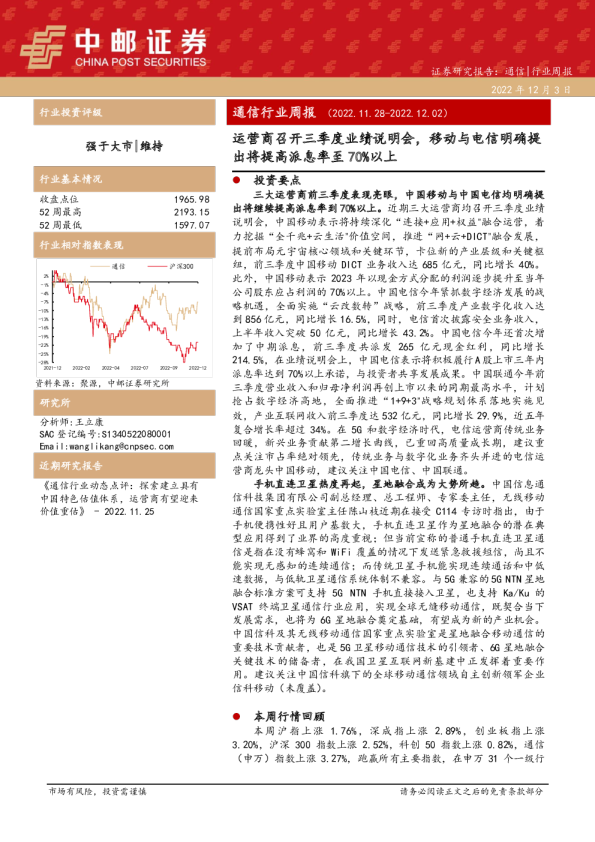2023全球消费者调研报告-电信运营商移动连接与固定连接
 AI智能总结
AI智能总结
电信运营商 : 移动和固定连接 2023 年 10 月 麦克伦南马什的生意 资格、假设和限制条件 本报告仅供文中所述的奥利维尔·温曼客户独家使用。本报告无意进行一般性分发或出版,也不得未经奥利维尔·温曼书面许可而复制、引用或以任何目的分发。本报告没有第三方受益人,奥利维尔·温曼不对任何第三方承担任何责任。 其他来源提供的信息被认为是可靠的,但除非另有明确说明,否则这些信息尚未独立验证。公开信息、行业数据和统计数据来源于我们认定可靠的数据源;然而,我们不对这些信息的准确性或完整性做出任何保证。本报告中的发现可能基于当前数据和历史趋势进行预测。任何此类预测都存在固有的风险和不确定性。奥莱Va曼(Oliver Wyman)不对实际结果或未来事件承担责任。 本报告中的意见仅适用于本报告所述的目的和报告日期。不承担因在此日期之后发生的变化、事件或情况而修订本报告的义务。 与本报告中所包含的建议或推荐的实施或使用相关的所有决策均为客户的独家责任。此报告不构成投资建议,也不提供任何交易对所有相关方的公平性的意见。此外,本报告不提供法律、医疗、会计、安全或其他专业建议。对于此类建议,欧力哲咨询(Oliver Wyman)建议寻求并获得合格专业人士的意见。 样品详细信息 电信运营商 :移动和固定连接 44% 的欧盟消费者计划切换他们的移动运营商。德国外汇更加稳定的交易动态 价格是整个市场中最相关的单一决策元素。TELCO 核心以外的 ESG 和整体发行不被视为具有竞争力的优势 请排名(1 - 10)决定时的因素你的下一个手机服务购买 考虑转换的受访者的平均排名(1 = 最重要 , 10 = 最不重要) 年轻的消费者更适合切换操作员- 这在德国是一个特别强大的模式 低成本操作员在不同年龄范围内表现出平衡的渗透在德国和英国的高级人士中表现突出 西班牙保持了欧洲和英国最低的最高收敛性渗透 2023 年 ; 同一运营商提供固定宽带和主要移动线路的家庭占比FMC 国家渗透率 在英国 , DE 和 IT ,融合对绑定移动消费者无效. 在 FR 和 ES在 70 % 以上的消费者拥有 FMC 产品的情况下 , 仍然可以看到适度的结合效果 您更换手机服务提供商的可能性有多大 ? 按国家划分的 FMC 对陈述偏好的受访者的渗透率 我们一直看到 A向低成本运营商迁移; 德国成为传统电信更有弹性的市场 只有 37% 的欧盟消费者愿意为 5G 连接支付额外费用 -意愿最高的意大利人在不同年龄段支付 5G 费用 42 % 的欧盟消费者计划切换其 FBB 操作员波动性大于移动 。在意大利和英国 , FBB 预计 类似于移动,价格,速度AND可靠性ARE THE关键决策要素选择新宽带提供商时 请排名(1 - 10)决定时的因素你的下一个宽带购买 考虑转换的受访者的平均排名(1 = 最重要 , 10 = 最不重要) 正如在移动中观察到的,年轻的成年人更有可能切换宽带提供商比其他年龄分段 与 5G 相反 ,FTTH 被视为跨年龄层的高级技术。只有在德国 , 部署速度较慢 , 消费者的利益才会降低 保密性 我们的客户行业竞争极为激烈,因此保护客户计划和数据的机密性至关重要。奥利弗·怀曼严格遵守内部保密实践,以保护所有客户信息的机密性。 同样,我们的行业非常具有竞争力。我们将我们的方法和见解视为专有信息,因此在提案、演示、方法论和分析技术方面寻求客户的保护。在任何情况下,未经奥利弗·怀曼的书面同意,不得将此材料分享给任何第三方。 © Oliver Wyman Marsh McLennan 的业务
你可能感兴趣

2014年通信、媒体与高科技数字消费者调研之电信运营商洞察:不断数字化的中国消费者,催生复合型数字化服务

2023 年世界移动通信大会 : 命中 , 错过和电信断开连接

2024年全球品牌与消费者的连接性调查报告:欧洲主要市场洞察

通信行业周报:运营商召开三季度业绩说明会,移动与电信明确提出将提高派息率至70%以上
